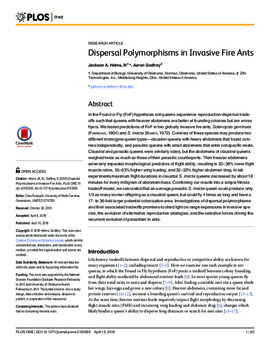| dc.creator | Helms, Jackson A. IV | |
| dc.creator | Godfrey, Aaron | |
| dc.date.accessioned | 2016-04-18T13:29:26Z | |
| dc.date.available | 2016-04-18T13:29:26Z | |
| dc.date.issued | 2016-04-15 | |
| dc.identifier.citation | Helms JA IV, Godfrey A (2016) Dispersal Polymorphisms in Invasive Fire Ants. PLoS ONE 11(4): e0153955. doi:10.1371/journal.pone.0153955 | en_US |
| dc.identifier.uri | https://hdl.handle.net/11244/33468 | |
| dc.description | S1 Dataset. Fire ant queen flight morphology and flight durations.
http://journals.plos.org/plosone/article/asset?unique&id=info:doi/10.1371/journal.pone.0153955.s001
doi:10.1371/journal.pone.0153955.s001
(XLSX) | en_US |
| dc.description.abstract | In the Found or Fly (FoF) hypothesis ant queens experience reproduction-dispersal tradeoffs such that queens with heavier abdomens are better at founding colonies but are worse flyers. We tested predictions of FoF in two globally invasive fire ants, Solenopsis geminata (Fabricius, 1804) and S. invicta (Buren, 1972). Colonies of these species may produce two different monogyne queen types—claustral queens with heavy abdomens that found colonies independently, and parasitic queens with small abdomens that enter conspecific nests. Claustral and parasitic queens were similarly sized, but the abdomens of claustral queens weighed twice as much as those of their parasitic counterparts. Their heavier abdomens adversely impacted morphological predictors of flight ability, resulting in 32–38% lower flight muscle ratios, 55–63% higher wing loading, and 32–33% higher abdomen drag. In lab experiments maximum flight durations in claustral S. invicta queens decreased by about 18 minutes for every milligram of abdomen mass. Combining our results into a simple fitness tradeoff model, we calculated that an average parasitic S. invicta queen could produce only 1/3 as many worker offspring as a claustral queen, but could fly 4 times as long and have a 17- to 36-fold larger potential colonization area. Investigations of dispersal polymorphisms and their associated tradeoffs promises to shed light on range expansions in invasive species, the evolution of alternative reproductive strategies, and the selective forces driving the recurrent evolution of parasitism in ants. | en_US |
| dc.description.sponsorship | This work was supported by the National Science Foundation Graduate Research Fellowship to JAH, and University of Oklahoma Alumni Fellowship to JAH. | en_US |
| dc.format.extent | 20 pages | |
| dc.format.extent | 10,132,903 bytes | |
| dc.format.medium | application.pdf | |
| dc.language | en_US | en_US |
| dc.relation.requires | Adobe Acrobat Reader | |
| dc.subject.lcsh | Fire ants -- Dispersal | en_US |
| dc.subject.lcsh | Fire ants -- Variation | en_US |
| dc.subject.lcsh | Queens (Insects) | en_US |
| dc.title | Dispersal polymorphisms in invasive fire ants | en_US |
| dc.type | Article | en_US |
| dc.type | text | |
| dc.description.peerreview | Yes | en_US |
| dc.identifier.doi | 10.1371/journal.pone.0153955 | en_US |
| dc.identifier.doi | 10.1371/journal.pone.0153955.s001 | |
| ou.group | College of Arts and Sciences::Department of Biology | en_US |
